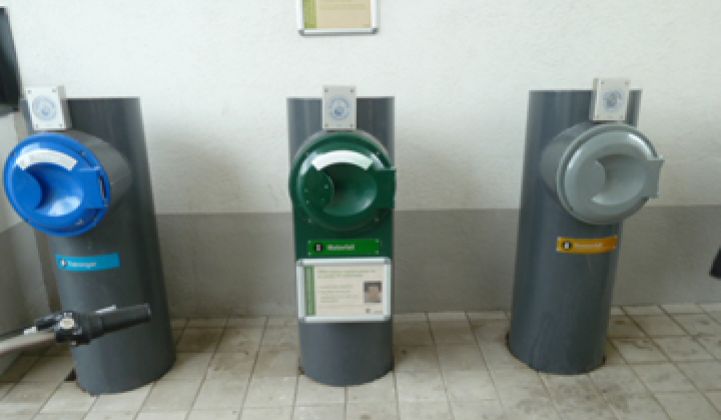STOCKHOLM --- For municipal waste fans, this is the equivalent of the electric car.
The Envac waste disposal system replaces the ritual of trash day and the noise and smell of garbage trucks with neighborhood-wide networks of vacuum tubes that whisk away trash any time you want.
Put your trash into hallway or sidewalk receptacles and a few seconds or minutes later it is whizzing off at 50 miles an hour to meet its maker. The organic waste heads to a facility where it gets converted to methane, the generic trash goes to an incinerator that feeds Stockholm’s district heating system, and the paper winds up at a recycling facility.
To top it off, the convenience of the system, as well as the fact that other residents might see you when you take out the trash, cuts down on people leaving extra bags of garbage on the sidewalk or trying to shove their crud into someone else’s trash cans.
“Your neighbors can see you recycling,” said Jonas Tornblum, director of marketing for Envac. “It is extremely rare to see someone doing the wrong thing. People would do that if it [the receptacle] was hidden.”
Envac installed its first vacuum network in the '60s in Stockholm. Since then, it has put in around 600 systems in South Korea and Southern Europe. While many of the systems have been installed in new neighborhoods, Envac has also installed them in cities with stringent historical preservation standards. Barcelona has one and another runs underneath the old quarter of Vitoria in Spain’s Basque regions. The pipes are placed around one to two meters underground.
The company, which pulled in around $200 million in revenue last year, is currently in discussions with New York City about a network.
Like the auto industry, the waste industry is in the midst of a transformation -- call it The Story of Garbage -- in which basic technologies and processes are getting retrofitted. And as with electric cars, the change Envac creates in underlying technology leads to a number of repercussions. First, of course, it’s a convenience for residents and it keeps trash off the streets.
Second, it makes trash disposal more environmentally friendly. Electric generators for the vacuum system effectively replace trucks. In Hammarby Sjostad, a live/work district planned around sustainability principles in Stockholm, Envac’s local network has reduced the number of diesel-burning collection vehicles by 60 percent (bottles and cans still get picked up by trucks.) The vacuum strength comes to around 20 to 30 kilopascal, which is considered a low-power vacuum.
But it also has an impact on land values. In Hammarby Sjosten, the company estimates that it adds about a half square meter to each household. A 17-kilometer network in Yongin City in South Korea serves around 14,000 apartments: a survey of residents showed that 70 percent thought it added to the value of their homes.
Over time, it’s also cost-effective. The system takes capital to install, but drastically cuts operating expenses. A set of receptacles can serve approximately 30 to 50 households. For each 2,000 or so residents, Envac builds a separating/processing center that effectively routes the trash from a neighborhood to the recycling processing centers.
Tornblum took me in one of these facilities. It resembles something out of a steampunk comic book. Blue and green pipes shuttling air and garbage hang overhead. Every few minutes, pneumatic valves open and trash begins to rumble through the pipes. Mysterious suction noises follow and off it goes.
No people work at the center full-time. It is a building on autopilot. Very little garbage, he added, gets stuck in the pipes.
The place didn’t even smell that bad. A slight whiff of rotting vegetables hung in the air, but it was about as strong as standing near a dumpster in a parking lot. The building emits little noise. If you didn’t know what it was, you’d mistake it for a self-storage facility.
Then there is the impact on recycling and fuel production. By making it easier to get rid of organic waste, the biogas facility down the line has a more stable flow of feedstock. In the Hammarby network, 95 percent of the waste that gets tossed into the green organic waste pipes can be converted into biogas.
Finally, other applications can be adapted to the system. In Barcelona, a hospital employs a vacuum system to send linens to the laundry: potentially, that can reduce the possibility of free-floating infections. Airports are studying how to get rid of all the cups and bottles after a flight. Vacuum receptacles at the end of terminals would eliminate the need to have trucks zipping between planes.
But in the end, the appeal really lies in the wacky, unexpected nature of it. Economics and energy savings will vary over time and by location, but you’ll always have the satisfaction of knowing that your garbage is flying through space at near-freeway speeds.



